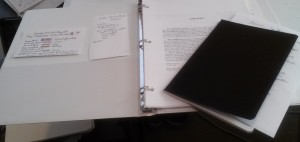I was struggling with a topic for an article, and was about to give up and end my streak of a post a day back to the end of January. Then I had a message indicator on my cellphone, and it hit me.
We have such small devices that handle all forms of communication: two way (calls, texting, email), and one way (received: emailed receipts, bill reminders, entertainment & sent: payments, notes/lists/reminders). Some phones have gone for bigger screens with higher resolutions for better experience, two cameras, motion sensors, GPS, etc.
If one does no have a cell phone in today’s world, good luck finding a pay phone. The only place I see pay phones now are in airports, and they take credit cards.
For a science fiction setting, one can imagine a computer as powerful or more so than today’s desktops, in the palm of your hand. The display will be holographic, so the size of the screen is variable. As dense as memory is getting, what limits will one have on a hand held computer/communicator?
Encyclopedic knowledge will be available, for topics that are in the system. Landing on a backwater or uncharted planet will present a world of unknown factors. Other than being able to check the atmosphere, and scan air, water, and potential food for pathogens/compatibility, how would this device help you?
Is it able to communicate to orbit? Can it make interplanetary calls, or signal ships passing through the system? How does GPS help when there are no GPS sattellites? Is there a star-faring version of GPS and do the general civilian devices have access, or does it require a separate device?
Would a general purpose device be capable of basic first aid, or contain the ability to guide the user in basic first aid, or perhaps something more advanced?
How tough/resilient would such a device be? I dropped a cellphone out of my pocket onto a cast iron floor vent in my house (It was built in 1920.) and it cracked diagonally across the screen. Touch screens don’t work so good, or at all when that happens. How far of a drop would it take to damage it? What water depth can it reach and for how long before it is compromised? What about the vacuum of space? There are also radiation, concussions from explosions, shrapnel from explosions, or projectiles from weapons.
Like today, there would be various levels of such devices, from cheap burners with an older interface. Now, burners tend to have actual buttons, but some small touch screens have appeared. In the future, an old interface might be a touch screen that require physical contact, and not have a holographic screen. They are severely limited in how much you can put on them. These are not as well made and would survive only so many hardships of daily use. How often do you have a player roll to see if their communicator survives a crash or fall, or fight?
Next would be the standard comm-puters that can handle more drops, but have a limit. My youngest son can still manage to crack a cellphone screen in less than a day. I’m glad I’m not responsible for his phone anymore.
Premium devices would be made of sturdier and more expensive stuff. Advertising how long they can stay in vacuum, and how long they can last at 100 meters, or some such.
At the pinnacle would be government/military grade devices that are resistant to a variety of abuses and resistant to cracking, i.e. “black hat hacking”.
How long does the battery last? A day, a week, a month, longer?
Instead of earbuds on a wire, there would be a vibration pad or pads you stick to your head behind your ears. Voice activation and voice recognition would be the norm. Minimal contact with the device would be needed. Placing it in your pocket or a shoulder bag and placing it for use of the holographic display could be the only times one touches such a device.
The device could be so small that the device(s) behind your ear(s) IS the comm-puter. Some societies might advocate implanting the device, especially so the government can keep an eye on you, “to keep you safe”. What if some nefarious organization or person cracks the system and uses it for mind control of the populace?
Take what we know of the current direction of technology and extrapolate it for a futuristic RPG. It gets smaller, more powerful, and more ubiquitous. It could end in nanobots that reside along the optic and auditory nerves and send signals straight to the brain. A display would be limited to the person, but could be shared with others within a certain range.
A fun thought experiment that have given me several more ideas, if I ever get things together for a science fiction campaign, either White Star or Metamorphosis Alpha.






